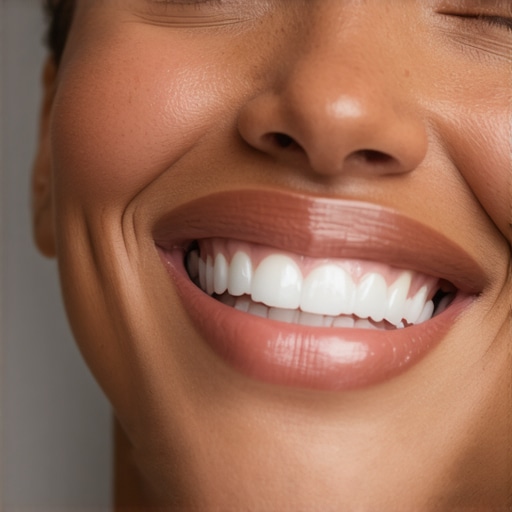Elevating Dental Aesthetics: The Critical Role of Combined Teeth Whitening and Invisalign in Modern Smile Design
In the realm of cosmetic dentistry, achieving a radiant and aligned smile has transcended traditional methods, embracing sophisticated, evidence-based approaches. The intersection of effective teeth whitening and Invisalign orthodontics exemplifies how integrated aesthetic solutions can significantly enhance facial harmony and boost psychological well-being. As we venture into 2024, understanding the nuanced dynamics of these treatments is essential for dental professionals aiming to deliver transformative results.
Decoding the Synergy Between Whitening and Invisalign: An Expert Perspective
While teeth whitening addresses chromatic imperfections, Invisalign corrects structural misalignments—each affecting smile confidence in unique yet interconnected ways. The strategic sequencing—whether whitening precedes or follows orthodontic correction—can influence outcomes and patient satisfaction. Recent studies in the Journal of Esthetic & Restorative Dentistry highlight that pre-orthodontic whitening can accentuate the visual impact of subsequent aligner therapy, provided enamel sensitivity is managed meticulously.
Complexity of Timing and Technique in 2024 Smile Makeovers
Expert practitioners now leverage advanced bleaching agents and customized tray protocols to ensure uniform shade enhancement without compromising enamel integrity. The advent of LED-activated whitening systems offers time-efficient, patient-friendly options that integrate seamlessly with Invisalign treatment plans. This dual approach demands precise coordination—highlighting the importance of multidisciplinary expertise and patient-specific customization.
How Do You Navigate Patient Expectations and Clinical Realities?
Achieving optimal results hinges on transparent communication about the limitations and realistic outcomes of combined teeth whitening and Invisalign. For instance, intrinsic discolorations—such as tetracycline stains—may require adjunctive procedures like veneers, which should be discussed during initial consultations. A comprehensive case assessment ensures that aesthetic goals align with biological feasibility, fostering trust and satisfaction.
Are There Emerging Technologies That Revolutionize Smile Enhancement?
Emerging digital smile design tools, augmented reality simulations, and AI-driven treatment planning are transforming how clinicians customize aesthetic interventions. These innovations enable precise prediction of combined whitening and orthodontic results, elevating patient engagement and confidence. For example, integrating 3D scans with virtual mock-ups allows for pre-treatment visualization, setting clear expectations and enhancing the overall experience.
What Are the Best Practices for Maintaining Results Post-Procedure?
Long-term stability of a bright, aligned smile depends on diligent oral hygiene, habit modification, and periodic touch-ups. The use of custom night guards and maintenance whitening treatments can sustain results over years. Furthermore, ongoing patient education about dietary choices and smoking cessation is vital, supported by evidence from the American Journal of Dentistry.
For advanced insights into optimizing smile enhancement strategies, consider exploring detailed guides at Smile Gum Care. Share your clinical experiences and contribute to evolving best practices in this dynamic field.
Innovative Approaches to Smile Preservation Post-Alignment and Whitening
Maintaining the brilliance and alignment of a smile after comprehensive cosmetic procedures requires more than routine oral care. Advanced protocols involve the integration of personalized maintenance plans that incorporate both at-home and professional interventions. Dental professionals now utilize digital monitoring tools, such as intraoral scanners and AI-based tracking systems, to assess stability and predict potential relapse, ensuring long-term success. For example, utilizing custom night guards not only preserves the results of Invisalign but also protects against parafunctional habits that can compromise whitening longevity.
How Can Emerging Technologies Redefine Personalized Smile Care?
Emerging digital innovations are revolutionizing how clinicians approach post-treatment maintenance. Augmented reality (AR) and virtual reality (VR) tools enable patients to visualize their smile over time, fostering greater engagement and adherence to maintenance routines. Additionally, AI algorithms analyze individual habits, dietary patterns, and biological factors, providing tailored recommendations for diet modifications, whitening touch-ups, and retainer use. According to a study published in the Journal of Dentistry, these technologies significantly enhance patient compliance and satisfaction, ultimately extending the lifespan of aesthetic results.
Could the integration of smart dental devices become the new standard for longevity in smile enhancement?
Smart dental devices, such as Bluetooth-enabled whitening trays or sensor-equipped night guards, are emerging at the forefront of personalized dental care. These devices provide real-time feedback on wear time, oral hygiene, and dietary factors, enabling clinicians to intervene proactively and adjust treatment protocols accordingly. Such innovations could revolutionize maintenance strategies, making it easier for patients to sustain their stunning smiles in the long term. For practical guidance on implementing these advanced tools, explore resources at Smile Gum Care.
If you’re interested in expanding your knowledge on maintaining aesthetic results, consider sharing your experiences or asking questions in the comments below. For more insights into modern smile care, visit Invisalign innovations and stay ahead in cosmetic dentistry advancements.
Integrating Biological Factors and Material Science for Long-Lasting Smile Aesthetics
While technological innovations and personalized maintenance plans are pivotal, understanding the biological underpinnings of enamel remineralization and stain resistance can dramatically influence long-term outcomes. Recent research published in the Journal of Dental Research emphasizes the role of salivary composition and fluoride ion exchange in maintaining enamel integrity post-treatment. Knowledge of individual biological responses enables clinicians to tailor interventions—such as prescribing specific remineralizing agents or dietary modifications—that bolster enamel resilience against staining and demineralization.
Leveraging Advanced Material Technologies for Post-Treatment Maintenance
Emerging dental materials, including bioactive glass composites and nanohybrid resins, offer promising avenues for enhancing the durability of aesthetic results. These materials facilitate better adhesion of whitening agents, promote remineralization, and provide a protective barrier against external staining agents. For instance, the application of bioactive glass-containing sealants can create a sustained release of fluoride and calcium ions, actively repairing micro-erosions and preventing relapse of discoloration or misalignment.
How does the integration of smart biomaterials impact long-term aesthetic stability?
Smart biomaterials respond dynamically to the oral environment, adjusting their properties to optimize protection and repair. Innovations such as pH-sensitive release systems and self-healing composites are under investigation, promising to maintain aesthetic stability in the face of variable oral conditions. According to a comprehensive review in the Journal of Dentistry, these materials could redefine preventive strategies, shifting from reactive repairs to proactive maintenance, thereby significantly reducing the risk of aesthetic relapse.
Personalized Digital Monitoring and Predictive Analytics for Smile Longevity
The future of aesthetic dentistry hinges on the seamless integration of digital monitoring tools and AI-driven predictive analytics. Devices equipped with intraoral sensors can track wear patterns, occlusal forces, and salivary pH levels, transmitting data for real-time analysis. When combined with machine learning algorithms, clinicians can anticipate potential relapse scenarios and intervene preemptively, customizing follow-up treatments with unprecedented precision.
For example, an AI-backed dashboard might alert a patient to early signs of whitening agent depletion or detect parafunctional habits that threaten alignment stability. This proactive approach not only preserves the initial aesthetic gains but also enhances patient engagement and confidence in their long-term smile maintenance plan, as supported by findings in the Advanced Dental Research.
Conclusion: Embracing Future Innovations for Aesthetic Excellence
As we push forward into an era marked by personalized, technology-enhanced dental care, the integration of biological sciences, novel materials, and digital analytics will be critical in achieving durable, natural-looking results. Dental professionals committed to lifelong smile optimization must stay abreast of these developments, continuously refining their protocols and adopting innovative tools that elevate patient care.
To deepen your expertise, consider exploring ongoing clinical trials and emerging research in biomaterials and digital health solutions—your patients deserve nothing less than cutting-edge, evidence-based aesthetic care. For dedicated insights and community engagement, visit Smile Gum Care Advanced Smile Maintenance.
Innovative Material Science: The Next Frontier in Smile Longevity
Emerging bioactive and nanotechnological materials are revolutionizing the durability of aesthetic dental treatments. Researchers have developed bioactive glass composites that actively promote remineralization, creating a formidable barrier against external staining and micro-erosion. These cutting-edge materials not only enhance adhesion of whitening agents but also serve as a proactive defense, extending the longevity of both whitening and orthodontic outcomes.
Is There a Role for Genetic and Microbiome Profiling in Personalizing Smile Maintenance?
Recent advances suggest that individual genetic predispositions and oral microbiome compositions significantly influence enamel resilience and stain susceptibility. By integrating genetic testing and microbiome analysis into routine assessments, clinicians can tailor preventive strategies—such as personalized remineralization protocols and targeted dietary recommendations—that optimize long-term aesthetic stability. For comprehensive insights, consult the Journal of Dental Research.
How Do Digital Twins Transform Predictive Smile Care?
The concept of digital twin technology—creating a virtual replica of a patient’s oral environment—enables dynamic simulation of treatment outcomes and relapse risks. By incorporating real-time data from intraoral sensors, clinicians can forecast potential changes in alignment and shade, allowing for preemptive adjustments. This predictive approach maximizes aesthetic longevity and elevates patient confidence in long-term results.
What Are the Ethical Considerations Surrounding AI and Data in Aesthetic Dentistry?
As AI-driven tools and data analytics become integral to personalized care, ethical issues such as data privacy, informed consent, and algorithmic bias warrant careful attention. Establishing transparent data governance protocols and ensuring equitable access to advanced technologies are essential for maintaining trust and integrity in aesthetic dental practice. For expert guidance, review publications from the Journal of the American Dental Association.
How Can Continuing Education Keep Pace with Rapid Technological Evolution?
Proactive engagement in specialized training programs, webinars, and industry conferences ensures clinicians remain adept at integrating novel biomaterials, digital tools, and predictive analytics into their workflows. Collaborations with interdisciplinary teams—including material scientists and data analysts—further refine expertise, fostering innovation and elevating patient care standards. Explore resources at Smile Gum Care to stay ahead in this dynamic field.
What are the most promising emerging technologies for enhancing smile stability?
Innovations such as self-healing composites, pH-sensitive remineralizing agents, and smart biomaterials responsive to environmental cues are under active investigation. These technologies aim to provide adaptive protection, reducing relapse and maintaining aesthetic excellence. Stay informed about ongoing clinical trials and breakthroughs by consulting the Journal of Dentistry.
Expert Insights & Advanced Considerations
1. Emphasizing Personalized Treatment Sequencing
Aligning the sequence of whitening and orthodontic correction is crucial; pre-orthodontic whitening can enhance aesthetic outcomes but must be tailored to individual enamel sensitivity levels, ensuring optimal results without compromising enamel integrity.
2. Leveraging Digital Smile Design and Predictive Analytics
Utilizing advanced digital tools and AI-driven predictive models enables clinicians to simulate treatment outcomes, forecast relapse risks, and customize maintenance protocols—maximizing long-term aesthetic stability.
3. Prioritizing Biological and Material Science Factors
Understanding biological responses, such as salivary composition and enamel remineralization, combined with cutting-edge bioactive materials, empowers practitioners to develop strategies that reinforce enamel resilience and prolong aesthetic results.
4. Integrating Smart Biomaterials and Digital Monitoring
The advent of smart biomaterials and intraoral sensors facilitates real-time monitoring of treatment stability, allowing for proactive interventions and personalized maintenance plans that sustain a radiant, aligned smile over time.
Curated Expert Resources
- Journal of Dental Research: Offers groundbreaking research on biological factors influencing enamel health and innovative material technologies for long-lasting aesthetic results.
- American Journal of Dentistry: Provides evidence-based protocols on whitening agents, remineralization strategies, and clinical best practices for combined aesthetic treatments.
- Smile Gum Care: A comprehensive platform featuring advanced guides on digital smile design, AI applications, and emerging biomaterials to elevate clinical outcomes.
Final Expert Perspective
In the evolving landscape of aesthetic dentistry, integrating insights on biological sciences, innovative materials, and digital analytics is paramount for achieving durable, natural-looking smiles. Embracing these advanced considerations in teeth whitening and Invisalign treatment planning ensures clinicians can deliver transformative results that stand the test of time. For those committed to excellence, engaging with ongoing research and technological innovations remains essential. Share your clinical experiences and explore further resources at Smile Gum Care, and help shape the future of smile aesthetics in 2024 and beyond.

